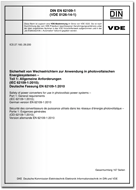IEC/TS 60815-1, which is a technical specification, is applicable to the selection of insulators, and the determination of their relevant dimensions, to be used in outdoor high-voltage systems with respect to pollution. For the purposes of this technical specification, the insulators are divided into the following broad categories, each dealt with in a specific part as follows:
- IEC/TS 60815-2 – Porcelain and glass insulators for a.c. systems;
- IEC/TS 60815-3 – Polymer insulators for a.c. systems;
- IEC/TS 60815-4 – Insulators for d.c. systems.
This part of IEC 60815 gives general definitions, methods for the evaluation of pollution site severity (SPS) and outlines the principles to arrive at an informed judgement on the probable behaviour of a given insulator in certain pollution environments.
This technical specification is generally applicable to all types of external insulation, including insulation forming part of other apparatus. The term “insulator” is used hereafter to refer to any type of insulator.
CIGRE C4 documents [1], [2], [3], [4] [no rendering defined for element: fn ] 1 References in square brackets refer to the bibliography at the end of the document. form a useful complement to this technical specification for those wishing to study in greater depth the performance of insulators under pollution. The object of this technical specification is to:
- understand and identify parameters of the system, application, equipment and site influencing the pollution behaviour of insulators,
- understand and choose the appropriate approach to the design and selection of the insulator solution, based on available data, time and resources,
- characterize the type of pollution at a site and determine the site pollution severity (SPS),
- determine the unified specific creepage distance (USCD) of “reference” insulator based on the SPS, and determine the appropriate test methods and parameters to verify the performance of the selected insulator if needed,
- determine the corrections of dimensions of the “candidate” insulators by taking into account the specific properties (notably insulator profile) of the site, application and system type,
- evaluate the relative advantages and disadvantages of the possible solutions,
- assess the need and merits of "hybrid" solutions or palliative measures.


